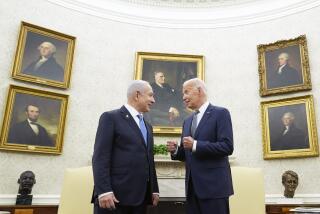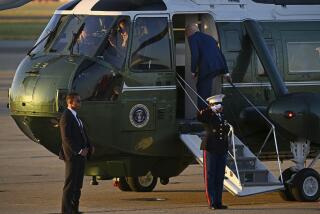CIA Sees Nothing New in Iraq’s Arms Disclosure
- Share via
WASHINGTON — The CIA delivered an initial assessment of Iraq’s declaration of banned weapons programs to the White House on Wednesday amid growing concerns that the bulk of the 12,000-page dossier consists of previously discredited Iraqi reports.
In particular, officials said, Iraq’s account of its nuclear weapons program -- totaling 2,081 pages, including a 113-page executive summary -- appears to be largely a duplicate of Iraqi declarations delivered to U.N. inspectors in 1996 and 1997.
Thousands more pages that Iraq submitted over the weekend on its biological and chemical weapons programs also appear to be copies of reports that U.N. weapons inspectors repeatedly rejected as inadequate and incomplete between 1995 and 1998, officials said.
“The initial conclusion is there’s nothing really new,” said one official who is assisting in the review. “What I’m hearing is it’s all recycled and [Iraqi claims that] it didn’t do anything wrong.”
The U.S. analysts are especially looking to see whether Iraq has adequately answered scores of questions left unresolved during the U.N. inspections that ended in 1998, and whether it can explain a body of intelligence since 1998 suggesting that Baghdad has rebuilt at least some of its proscribed weapons programs.
Several Arabic-language portions of the report, including a 300-page section that details Iraqi industrial and other facilities involved in nuclear research or development, have now been translated and are undergoing what the official called a “line-by-line review to see if [Iraq] inserted something that wasn’t in previous reports.... Nothing has emerged yet.”
The White House softened its rhetoric on Iraq this week as the review got underway. But a determination that President Saddam Hussein’s regime failed to provide an accurate and complete account of its proscribed weapons programs, as mandated by a Nov. 8 resolution by the U.N. Security Council, almost certainly would rekindle Bush administration efforts to disarm Baghdad by force.
“All the indications are so far that Iraq has taken a hard line,” said David Albright, a former nuclear weapons inspector in Iraq and president of the Institute for Science and International Security, a Washington think tank. “Perhaps Saddam has decided war is inevitable, so why give up anything? Either that, or they want to give things up gradually and see what happens.”
Pressure is growing on the CIA to complete its assessment. Hans Blix, the chief United Nations weapons inspector, said Tuesday that he planned to complete his analysis by Friday and give a censored version of the raw document to the full Security Council as early as Monday. Details are expected to quickly leak at that point.
The council’s five permanent members -- the United States, Britain, Russia, China and France, all of which already have nuclear weapons -- are receiving unedited copies of the report.
Blix said he would delete especially sensitive material -- including any blueprints or other designs for nuclear weapons, as well as plans for converting short-range missiles to long-range rockets -- before handing over the document. He said he is focusing on a 3,000-page section that includes fresh details about Iraq’s activities since U.N. inspectors withdrew four years ago. The CIA is still studying the trove of documents and CD-ROMs with teams of weapons specialists and other experts from the Pentagon’s Defense Intelligence Agency, the State Department’s Intelligence and Research division, the Energy Department’s Office of Intelligence, and a group of nuclear scientists and technicians from the Los Alamos National Laboratory in New Mexico, among others.
“It’s an ongoing process,” an intelligence official said of the CIA-led review. He said the agency is providing regular updates to the White House “as our work proceeds.”
Gaps in Iraq’s previous declarations of its biological and chemical weapons program are of special concern, officials said. And Iraq has a history of using fresh packaging for old reports.
A summary of the previous U.N. inspection effort in Iraq, issued in January 1999, notes that Baghdad denied even having a biological weapons program until 1995, for example, and that it used “fraudulent statements, forged documents, misrepresentation of the roles of people and facilities and other specific acts” to perpetuate the deception.
After a senior Iraqi defector first revealed the clandestine effort in July 1995, Baghdad issued three “full, final and complete” declarations of its germ warfare research and production efforts.
The first was declared null and void by Iraq. The second, in June 1996, was rejected by U.N. inspectors as incomplete. The third, issued in September 1997, “contained no new significant information from the previous one” and was “deficient in all areas,” according to the U.N. report.
Iraq then appealed for a review and met a team of U.N. experts in Vienna in March 1998. “Iraq did not present any new information at that meeting and the experts therefore reviewed the same material for the third time,” the report notes.
The inspectors particularly cited conflicting or insufficient credible details on the production and location not only of such bulk biological warfare agents as anthrax, botulinum toxin, aflatoxin and wheat smut, but also of warheads designed to deliver them. In many cases, Iraq claimed that it had destroyed the weapons but could produce no proof that it had done so.
“They basically gave ‘the dog ate my homework’ excuse -- that when they destroyed their biological and chemical weapons, they destroyed their documents as well,” said Jonathan Tucker, another former U.N. inspector. “We know that’s false.”
Officials are also looking to see whether Iraq can explain its apparent attempts to procure and import uranium and specialized parts for nuclear weapons development since 1998.
One official said Iraqi officials have privately acknowledged making five covert attempts since 1998 to obtain highly specialized aluminum tubes from overseas sources. The Iraqis said the tubes were intended for conventional artillery rockets.
White House officials this fall accused Iraq of trying to import the tubes to build a gas centrifuge to enrich uranium for nuclear bombs. Several U.S. scientists questioned the claim, however, asserting that the tubes were the wrong dimensions for centrifuges.
Iraq’s nuclear weapons program was essentially destroyed or dismantled by the time weapons inspectors left in 1998, according to the International Atomic Energy Agency. But U.S. and British intelligence reported in October that Hussein’s regime had secretly continued and even accelerated its effort to build a nuclear bomb since then.
A senior Iraqi official in Baghdad last weekend admitted for the first time what U.S. and U.N. officials concluded years ago: that Iraq was only six months or so from assembling a workable nuclear device when Hussein invaded Kuwait in 1990. The attack led to the Persian Gulf War in 1991 and the subsequent U.N. effort to disarm Iraq of any weapons of mass destruction.
The listings of production and other weapons sites in the Iraqi dossier are proving useful to U.N. inspectors. Newly reinforced teams of inspectors visited six suspect sites Wednesday, the most in a day since inspections began two weeks ago.
One group visited the Karama factory in Baghdad for missile and tank parts. The factory was built in 1999 and is part of Iraq’s Military Industrialization Commission, but Iraqi officials insisted that nothing illegal was being done there.
“We make precision parts for Al-Samoud missiles,” Brig. Kamel Saeed, the director, told reporters who toured the site after the U.N. team left. The 60-foot rocket has a maximum range of 95 miles, which is permitted under the Gulf War cease-fire terms.
Hiro Ueki, a spokesman for the inspectors, said in a statement that Iraq had included the site in a declaration it submitted Oct. 1 in Vienna. That declaration focused on factories and facilities that used so-called dual-use materials or parts that might have military applications.
Another weapons facility at the site was bombed by U.S. warplanes in late 1998, Saeed said. The U.N. experts checked machines previously tagged by arms teams at the destroyed facility.
“They checked and found everything is OK. There were no provocations but questions, and we answered them,” Saeed added. U.N. officials declined to characterize the visit.
More to Read
Sign up for Essential California
The most important California stories and recommendations in your inbox every morning.
You may occasionally receive promotional content from the Los Angeles Times.














